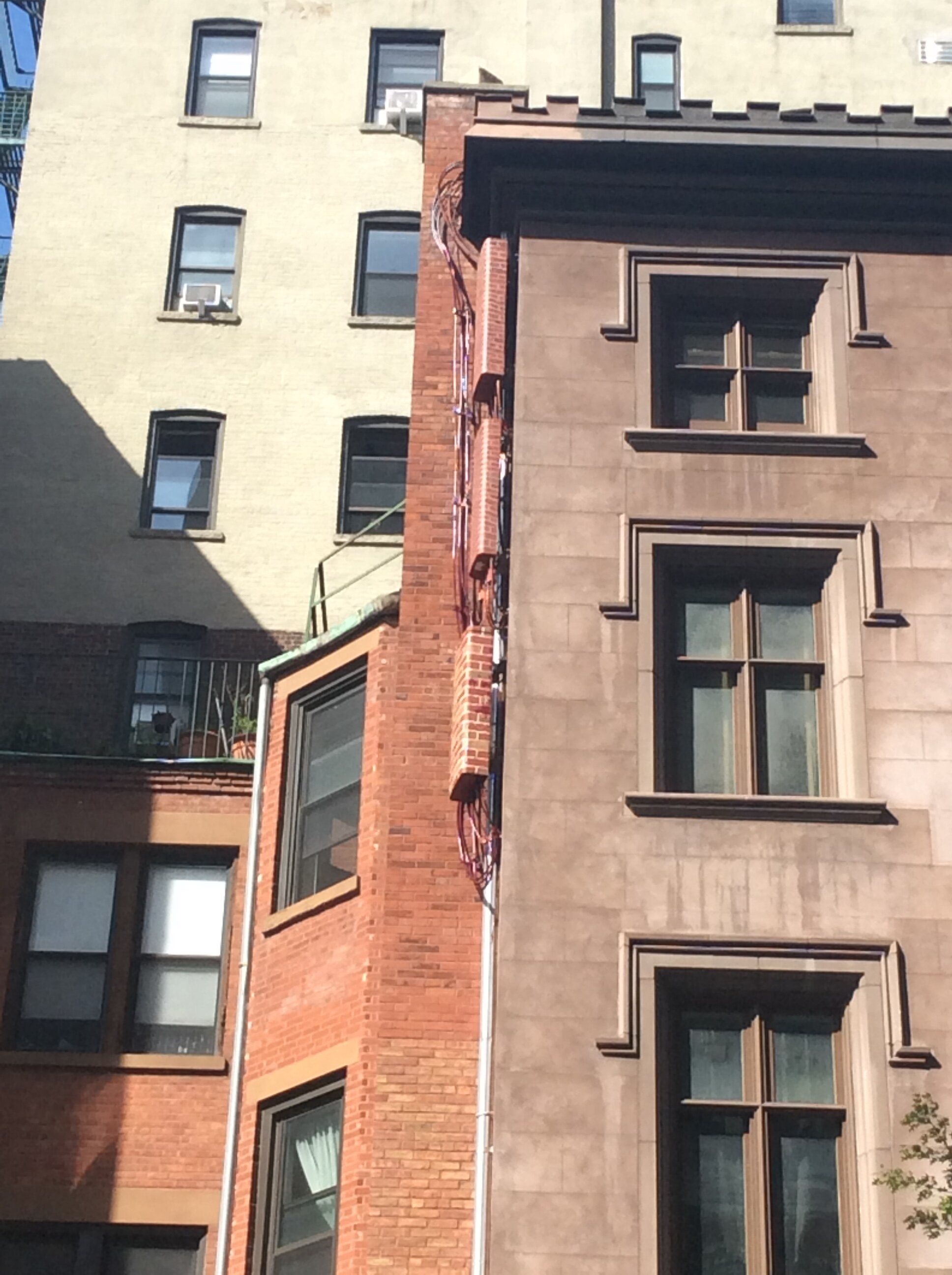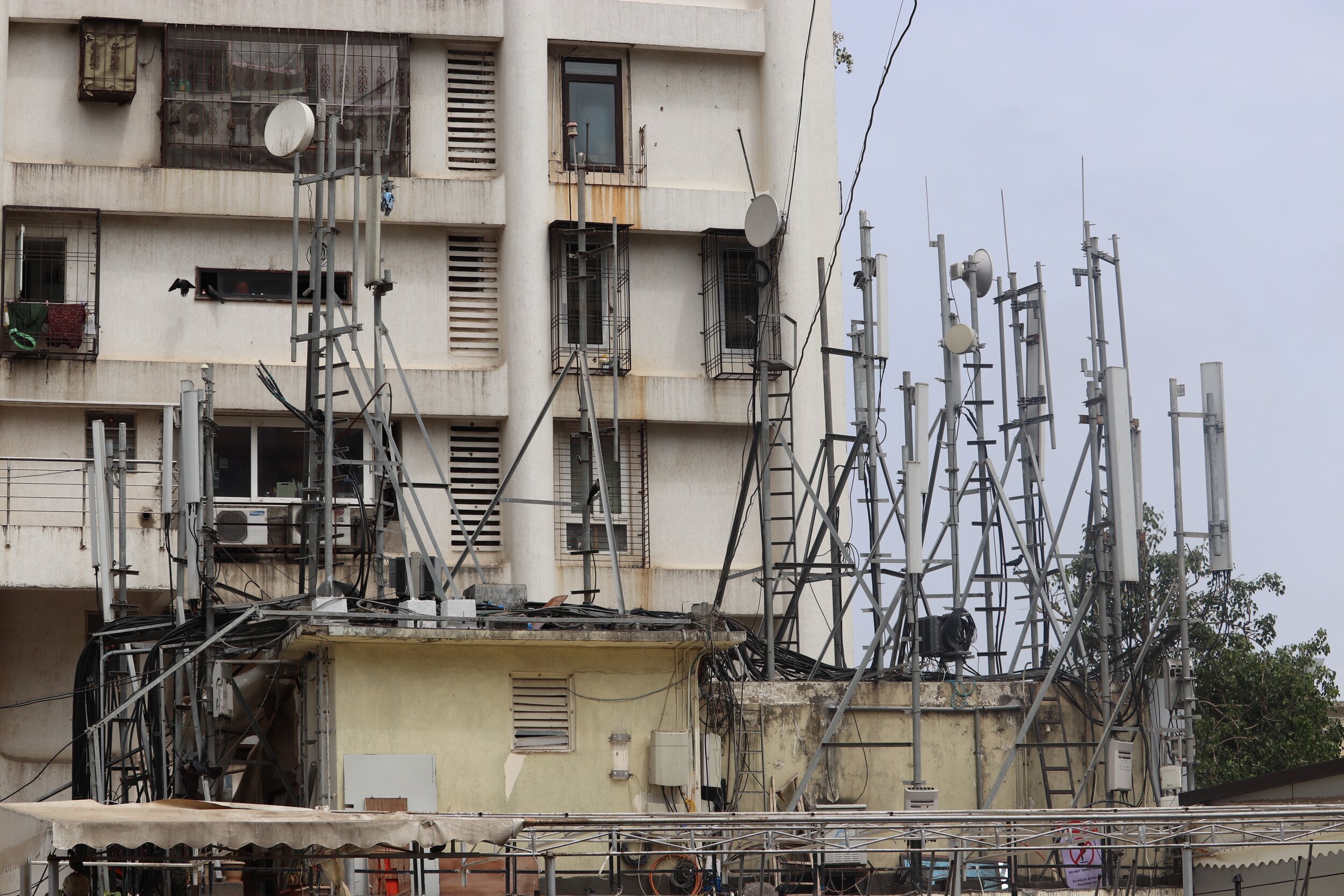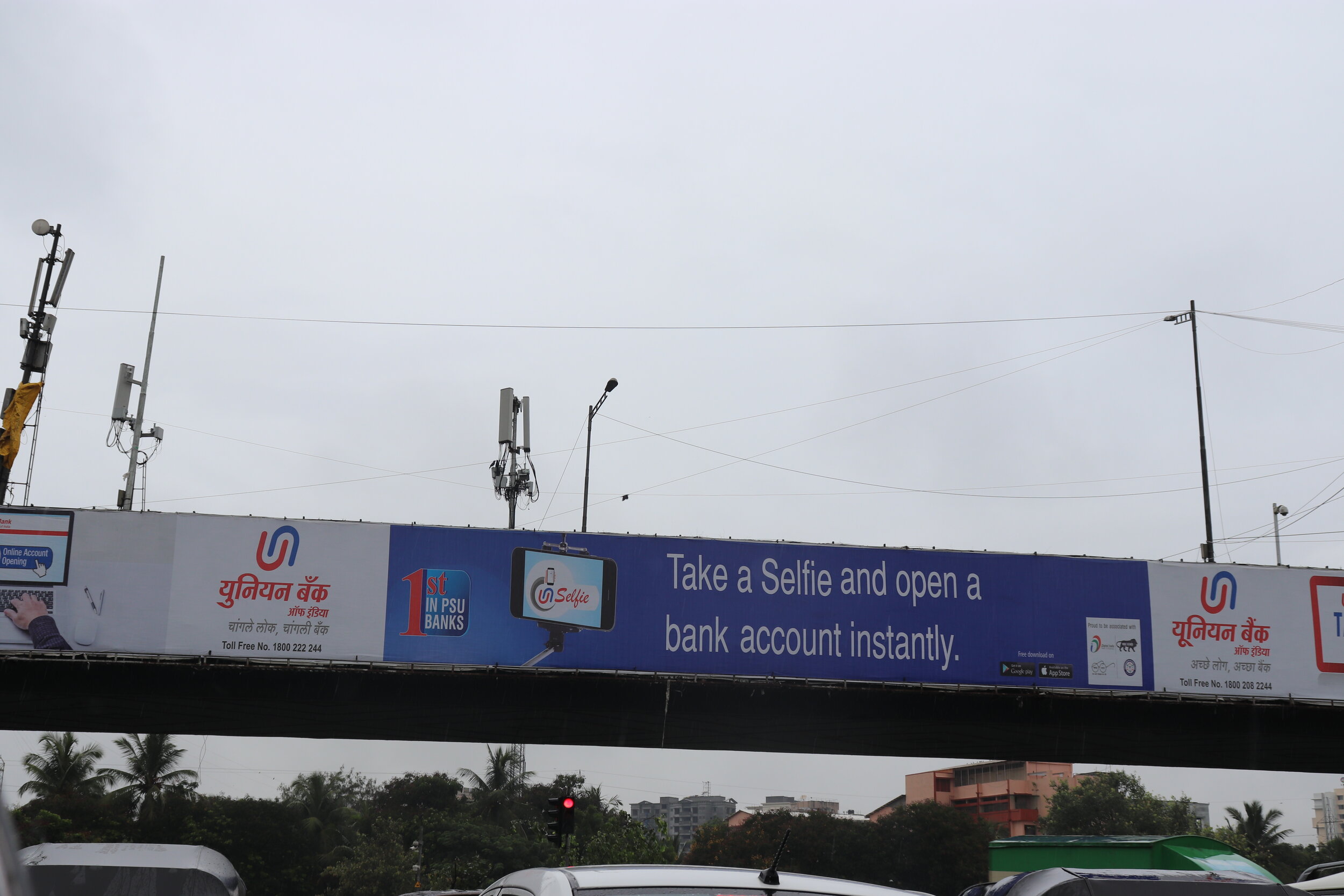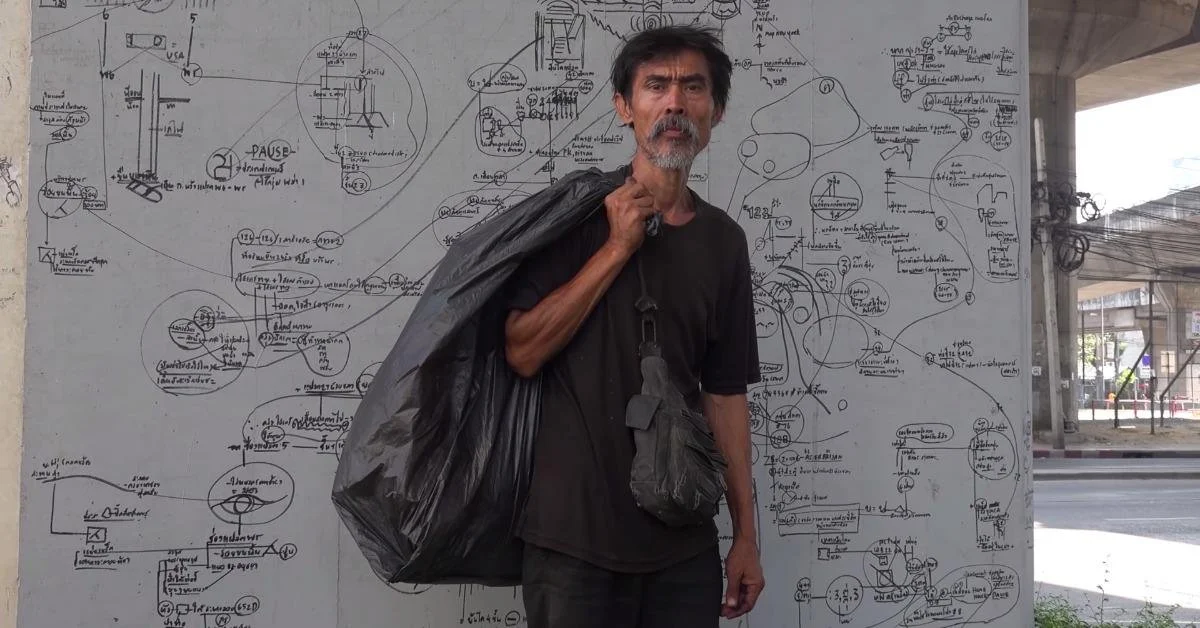(Un)wanted Proximities with Infrastructure: Antenna Trees, Overhead Tanks, and Slums
I often stop to take pictures of camouflaged cell antennas that tend to blend with the built landscape. This image of a cell antenna in New York City at the intersection of East 8th Street and 5th Avenue, with its brick-like fascia, is one example of the different ways cell antennas are concealed or made inconspicuous (figure 1).
Figure 1. Camouflaged cell antenna in New York City. Photograph by Rahul Mukherjee.
Cell antennas are at times considered eyesores, and at other times their proximity to residential buildings creates anxieties among those who live close to them. Hence the cell tower equipment manufacturers’ desire to disguise them as antenna trees (where cell antennas are painted green and “planted” among trees), or other kinds of “stealth towers” designed to look like church steeples, mosque minarets, and grain silos.[1] Wireless companies continue to see the antenna tree as a strategy to appease the Not In My Backyard (NIMBY) activists and environmental groups.
We tend to not notice cell antennas till perhaps our mobile phone’s signal gets weak or we experience call drops. The camouflaging of cell antennas not only points to a certain aesthetics of infrastructural representation inflected by infrastructural (in)visibilities, but also gestures toward the problem of proximity that urbanites have with cell towers. When I began studying cell antennas more than ten years ago, some residents living in apartment complexes in urban India were complaining about the siting of cell antennas near them, but these complaints were made sporadically, and most often brushed aside. By 2010, objections had become louder with mainstream news outlets (both at the national and local level) in India covering some of these cases in Jaipur, Delhi, and Mumbai. People were afraid that by living close to cell towers, they were being exposed to unregulated wireless signals that could be potentially carcinogenic. Others complained that signal emissions from cell antennas were making them suffer from anxiety, headache, and sleeplessness. Lifestyle TV shows (like Living it Up) depicted children playing under the shadow of a cell tower with camera tilts to emphasize the tower’s enormous height.
Telecom regulators are aware of citizens’ concerns, but cell phones are an important part of India’s development story. Since India has a high population density, and cities particularly are densely populated, cell antenna density has to be high to meet the call and data requirements of millions of cellphone users. J. S. Deepak, the secretary of the Department of Telecom (DoT), noted at an “awareness session” on October 28, 2016, that “if we want good quality communication 24/7, mobile towers will have to be present just like overhead tanks.” Through this infrastructural analogy, the DoT secretary was arguing that just as every terrace had an overhead tank for water supply, terraces should have cell antennas for information connection. The mobile phone had become a great equalizer, allowing many poor people to enter the Indian economy with new vibrancy. As such, stopping the growth of telecom infrastructure in the name of environmental ramifications, Deepak warned, was going to perpetuate the digital divide between the wealthy/connected and poor/unconnected. The regulators consign the apocalyptic time of the environment to the distant future, while present-day expediencies of digital divides are given top priority.[2]
Cell antennas might be aesthetic eyesores for some and potentially carcinogenic for others, but there are still those who consider these infrastructures to be a part of Indian modernity that guarantees they can use their sleek mobile phones. The proximity of cell towers to nearby buildings and their obdurate fixity/immobility makes them a problem for the locality. Elite urbanites certainly have the cultural capital to have stories about their struggles against malpractices of telecom companies be included in the pages of prominent newspapers. In 2011, the Mumbai edition of Times of India carried a story titled “No Civic Nod for 3 Cell Towers atop Building: RTI.” The article mentioned that Harish Pandey of the New Link Road Residents’ Forum in Mumbai had filed an RTI (Right to Information) query which revealed that the mobile operator had installed three cell towers on the roof of Victor Shelter apartments without permission of the civic body. Residents of another nearby apartment building, Nilesh Society at Kandarpada in Dahisar were especially affected by these unauthorized towers. Nilesh Society residents complained of headaches, inability to concentrate, memory loss, and joint pain. These unregulated cell antennas had to be removed.
These debates about cell antennas fall within larger claims about “pollution”-free cities. Anti-poor, middle-class elites in urban centers have used the judicial activism of PILs (Public Interest Litigation) and RTIs to remove slums and beautify cities. The geographer D. Asher Ghertner (2011) writes that the early 2000s witnessed a “drastic increase” in PILs against slums by “resident welfare associations.”[3] These were associations of property owners that gave “neighborhood security” and “local environmental issues” as reasons for evicting slums. There are online blogs maintained by residents’ associations that targeted slum settlements for causing pollution in their neighborhoods. In these blogs, residents’ associations also argue that cell antennas are polluters and as a public nuisance these should be removed. While elite urbanites did not explicitly equate slums and cell antennas, they viewed both as polluters. These urban elites carrying out “bourgeois environmentalism,” to use Amita Baviskar’s term, are impatient with bureaucrats and ministers for not doing enough to remove cell towers, hawkers, and “illegal” slums. [4] The anti-cell tower activism certainly demonstrated some elements of bourgeois environmentalism.
That said, the regulatory problems they pointed to with the siting of cell towers and the non-compliance of telecom officials and cell antenna operators with respect to the threshold level of signals was also a legitimate concern. Regulations set by the DoT and municipal corporations were openly being flouted by cell tower companies and commercial establishments that offered their rooftops to cellular operators to set up towers. Gaurav Bhatia lives in Clover Apartments in the Cuffe Parade area in Mumbai. He fears for the health of his pre-teen son and daughter because of twenty-nine cell antennas that are located on the rooftop of Hotel Supreme, a commercial establishment next to his residential complex. The view of the terrace of Hotel Supreme from Bhatia’s balcony gives some sense of just how brazenly the laws regarding cell antenna siting have been disregarded (figure 2). Hotel Supreme is only three floors high, but the apartments that surround it have more than twenty floors. The antennas are angled upward, which makes residents of the posh apartments worried about their safety. It remains debatable whether the weight of twenty-nine antennas can be sustained by the Hotel Supreme structure itself. Therefore, the Brihanmumbai Municipal Corporation could not possibly allow the structures to remain. Bhatia and residents of other neighboring apartments had moved a petition to the Mumbai High Court, and after the ruling, a number of antennas were removed in March 2017. After the removal drive that took place that same month, only seven antennas remained, but in May 2017 more towers were added, bringing the number of antennas to twenty-two.[5]
Figure 2. Cell antennas atop Hotel Supreme, Mumbai. Photograph by Rahul Mukherjee.
The cell towers in urban India thus found themselves in messy entanglements with regulatory bodies, developmental narratives, and radiation controversies. Cell towers as disruptive technologies gathered a variety of stakeholders, and depending on who I was meeting (cellular operator, affected patient, oncologist, health journalist, regulator, economic journalist, anti-radiation activist) for a research interview, I would end up hearing a different story, a different take on the infrastructure. Cell towers had become both public and private technologies: they were privately owned and were a source of rent for apartments hosting them, but their signals (and radiations) imperceptibly (and invisibly) moved through public places, and served the mobile phones of a variety of publics (customers) traveling through the location.
Figure 3. Cell antenna and mobile banking ad, Mumbai. Photograph by Rahul Mukherjee.
By way of a conclusion, I want to briefly reflect on another photograph I took in Mumbai, which presents the juxtaposition of the cell antenna infrastructure and a mobile banking ad (figure 3). This was at an overpass and underpass intersection at Ghatkopar. Cell antennas are a common sight on both ends of roads and bridges in Mumbai because these infrastructures help phones to remain connected as mobile media users travel in cars and buses. The mobile banking ad of the Union Bank of India just happened to be there, and it reads, “Take a selfie and open a bank account instantly.” Mobile banking has been very steadily promoted by Prime Minister Narendra Modi and his Bharatiya Janata Party government as a way to make bank accounts and digital transactions available to every Indian in the country. This is part of Modi’s “Digital India” mission. Getting a bank account is not as easy as taking a selfie, but this ad, aspirational in nature, wants to convey the possibilities for growth and development that just having a mobile phone affords and enables. The physical presence of the cell antenna infrastructure next to the mobile banking ad (perhaps not even by design) makes the infrastructure conspicuous and visible as supporting/facilitating the work of the mobile phones, and providing the possibility for the selfie being taken to be uploaded to the bank’s app. In the event of such developmental aspirations embodied by cell antennas, will environmental concerns about their regulation be heard or acted upon? The narrative of the cell towers in India continues to unfold, and it is both radiant and murky.
NOTES
[1] Lisa Parks, “Around the Antenna Tree: The Politics of Infrastructural Visibility,” Flow: A Critical Forum on Media and Culture, 2010.
[2] Rahul Mukherjee, Radiant Infrastructures: Media, Environment, and Cultures of Uncertainty (Durham: Duke University Press, 2020). The above paragraph is excerpted from the book with some changes.
[3] D. Asher Ghetner, “Green Evictions: Environmental Discourses of a Slum-Free Delhi,” in Global Political Ecology, eds. Richard Peet, Paul Robbins, and Michael Watts (Routledge: London, 2011), 145-166.
[4] Amita Baviskar. “Cows, Cars and Cycle-Rickshaws: Bourgeois Environmentalists and the Battle for Delhi’s Streets,” in Elite and Everyman: The Cultural Politics of the Indian Middle Classes, eds. Amita Baviskar and Raka Ray (New Delhi: Routledge, 2011), 391-418.
[5] Rahul Mukherjee, “Imagining Cellular India: the Popular, the Infrastructural, and the National,” in Global Digital Cultures: Perspectives from South Asia, eds., Aswin Punathambekar and Sriram Mohan (University of Michigan Press, 2019), 76-95.








